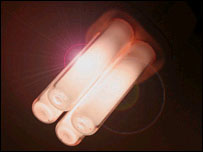Low-energy bulbs 'worsen rashes'
By keminem001
@keminem001 (779)
Saint Lucia
January 4, 2008 2:59pm CST
The switch to energy-saving light bulbs may put thousands at risk of painful skin reactions, health charities warn.
Fluorescent bulbs can exacerbate skin rashes in people with photosensitive skin conditions, experts said.
The government is planning to prevent the sale of conventional bulbs by 2011 to cut carbon dioxide emissions.
Several groups including the British Association of Dermatologists called for exemptions to allow those affected to continue using traditional bulbs.
But representatives of the lighting industry said there would be alternatives to fluorescent lighting available.
Health conditions which can involve some form of light sensitivity, include the auto-immune disease lupus, the genetic disorder Xeroderma Pigmentosum (XP), certain forms of eczema and dermatitis, photosensitivity, and porphyria.
It has been estimated about 100,000 people in the UK with these skin conditions will be affected.
Spectrum - an alliance of charities that support people with light sensitive conditions - says they have also been contacted with people suffering from ME who have had bad reactions to fluorescent light.
Other groups have warned that low-energy bulbs, which use approximately a quarter of the energy of conventional bulbs, cause migraines and increase the risk of seizures in people with epilepsy.
Phase-out
Conventional or "incandescent" bulbs are being phased out in a voluntary agreement with retailers and will no longer be on sale from December 2011.
Campaigners want people who have light sensitive conditions to be able to continue to buy conventional bulbs for their homes.
They warned that employers must also be able to purchase incandescent lighting as employees have a right to such adjustments under the terms of the Disability Discrimination Act.
Andrew Langford, chief executive officer of the Skin Care Campaign, one of the charities involved, said: "Incandescent light bulbs are the only source of electric light for many thousands of people with light sensitive conditions."Add to this the thousands of people whose conditions or treatments may secondarily cause them to be light sensitive, and you have a large number of people potentially being isolated in the dark."We certainly don't want to say no to greener bulbs just that other bulbs need to be available."It's hard for people to understand what it's like to live with one of these conditions."He also called for a government-funded study into the effects of fluorescent lighting on photosensitive conditions as little research had been done to date.
"We have the anecdotal information - it's a shame people don't listen to those affected.
Dr Colin Holden, President of the British Association of Dermatologists, said: "It is important that patients with photosensitive skin eruptions are allowed to use lights that don't exacerbate their condition.
"It is essential that such patients are able to protect themselves from specific wavelengths of light emitted by fluorescent bulbs, especially as they are often trapped indoors because they can't venture out in natural sunlight."
Kevin Verdun, chief executive of the lighting association said only two-thirds of incandescant bulbs were being phased out.
"These things have been taken into consideration and there will be bulbs they can still use.
"There are also halogen bulbs and LED bulbs coming in in the next two or three years."
http://news.bbc.co.uk/2/hi/health/7170246.stm
1 response
@highflyingxangel (9225)
• United States
4 Jan 08
That is definitely something I did not know. Those bulbs are definitely great assests, but obviously some people should not use them. I only hope that people that they actually find out about it before they use them and adjust accordingly.
1 person likes this
@keminem001 (779)
• Saint Lucia
5 Jan 08
i'm always willing to bring this information to you guys. just make sure that you guys make the best use of it.
thanks for your input.





